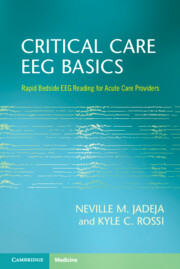Book contents
- Critical Care EEG Basics
- Critical Care EEG Basics
- Copyright page
- Dedication
- Contents
- Foreword
- Preface
- Acknowledgments
- How to Read This Book
- Part I Introduction
- Part II Case-Based Approach to Specific Conditions
- Chapter 9 Nonconvulsive Status Epilepticus (NCSE)
- Chapter 10 Management of the Ictal‐Interictal Continuum (IIC)
- Chapter 11 Seizures and Epileptiform Discharges
- Chapter 12 Seizure Mimics
- Chapter 13 Focal Lesions
- Chapter 14 Encephalopathy
- Chapter 15 Coma
- Appendix Understanding EEG Reports
- Index
- References
Chapter 10 - Management of the Ictal‐Interictal Continuum (IIC)
from Part II - Case-Based Approach to Specific Conditions
Published online by Cambridge University Press: 22 February 2024
- Critical Care EEG Basics
- Critical Care EEG Basics
- Copyright page
- Dedication
- Contents
- Foreword
- Preface
- Acknowledgments
- How to Read This Book
- Part I Introduction
- Part II Case-Based Approach to Specific Conditions
- Chapter 9 Nonconvulsive Status Epilepticus (NCSE)
- Chapter 10 Management of the Ictal‐Interictal Continuum (IIC)
- Chapter 11 Seizures and Epileptiform Discharges
- Chapter 12 Seizure Mimics
- Chapter 13 Focal Lesions
- Chapter 14 Encephalopathy
- Chapter 15 Coma
- Appendix Understanding EEG Reports
- Index
- References
Summary
This chapter describes the practical aspects of recognizing and managing electrographic patterns that may constitute an ictal–interictal injury continuum (IIIC) using a case-based approach. Plus [+] modifiers include superimposed fast activity (+F), spike/sharp activity (+S), or rhythmic delta activity (+R). If present, these features suggest the pattern is more likely associated with ictal activity. Evolution refers to at least two distinct changes in either frequency, morphology, or location with time and is an electrographic hallmark of seizures. Patterns that do not qualify for definite electrographic seizures but may still contribute to deterioration of neurological function may be referred to the IIIC and should be managed appropriately. Finally, the chapter describes nonictal and stimulus induced patterns.
Keywords
- Type
- Chapter
- Information
- Critical Care EEG BasicsRapid Bedside EEG Reading for Acute Care Providers, pp. 144 - 159Publisher: Cambridge University PressPrint publication year: 2024

